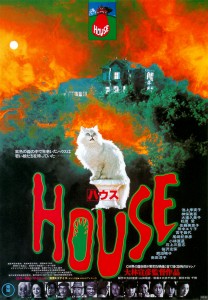AKA: Ring vs Ju-On
Director: Koji Shiraishi
Cast: Mizuki Yamamoto, Tina Tamashiro, Aimi Satsukawa, Masahiro Komoto, Masanobu Ando
Running Time: 99 min.
By Paul Bramhall
Starting any review of Sadako vs Kayako might as well begin with a recap of the two titular horror movie franchises that they’re a part of.
As the cursed spirit of the Ringu series, this installment notches up Sadako’s twelfth onscreen appearance (soon to be thirteenth, with the 2016 release of the Hollywood production Rings). Based on a novel by Koji Suzuki, Sadako initially appeared to terrify viewers in a 1995 Japanese TV movie, entitled Ringu: Kanzenban, however the character didn’t really catch on until the release of director Hideo Nakata’s 1998 adaption, Ringu. Between 1998 – 2000 there was another Japanese interpretation on the original novel (Rasen), a direct sequel, also helmed by Nakata, a prequel (Ringu 0), a Korean version (The Ring Virus), and a Japanese TV series (Ringu: The Final Chapter). Hollywood then attempted to reinterpret the character for western audiences with a re-make in 2002, which was followed by a sequel in 2005 (interestingly, also directed by Nakata). Then all went quiet on the Sadako front, until 7 years later Japan decided to revive the black haired spirit for the social media generation, with the disastrous efforts that were Sadako 3D and its sequel, both directed by Tsutomu Hanabusa, released in 2012 and 2013 respectively.
Kayako, as the equally cursed spirit that haunts the Ju-On series, almost matches Sadako for screen appearances, but not quite. There are eleven movies in the Ju-On series, with Kayako featuring in nine of them. Director Takashi Shimizu was behind the initial entries, which began with the DTV feature Ju-On: The Curse in 2000, and was followed up by a sequel in the same year. With Japanese horror becoming popular, Shimizu went on to make the theatrically released Ju-On: The Grudge in 2002, which was also followed up with a sequel the following year. Like Ringu, Hollywood decided to remake the latter entries, which were released as The Grudge and The Grudge 2 in 2004 and 2006 respectively, also both directed by Shimizu. For those wondering, yes, he’s basically made two of his movies three times over. There was a third Hollywood sequel in 2009, and during the same year two Ju-On movies unrelated to Kayako were released in Japan (White Ghost and Black Ghost). Much like Sadako, Kayako reappeared in Japanese cinemas after a several year absence with the release of 2014’s Ju-On: The Beginning of the End, which was swiftly followed by Ju-On: The Final Curse a year later, both directed by Masayuki Ochiai.
Perhaps then, much like Freddy Kruger and Jason Voorhees eventually ended up facing off against each other, it’s not such a surprise that a movie has been created which pits the two spirits against each other. While the concept sounds ridiculous, after all both series best entries rely more on a foreboding sense of dread rather than imaginative kills or jump scares, the fact that Koji Shiraishi was announced as director was a sign that this could be an interesting movie. Shiraishi has worked almost exclusively within the horror genre, and is the man behind such titles as The Slit Mouthed Woman (which he manages to work in a reference to in Sadako vs Kayako), and perhaps most notoriously, Grotesque, which was banned from distribution in the UK. When Shiraishi is on form, he’s a director who knows how to balance horror, both visceral and psychological, with fleshed out characters and drama.
Within the first 15 minutes of Sadako vs Kayako, it becomes apparent that this isn’t going to be one of those movies. In fairness, the blame can’t be put entirely on Shiraishi. The whole idea for a movie which sees the infamous pair facing off started as an April Fool’s joke, and eventually became a reality after momentum gained from fans demanding to make it happen. So what we have here is a movie which was supposed to be just a joke. What’s left is a lot of unintentional campiness, more contrived situations than you can shake a stick at, and characters who are so idiotic you actually look forward to the horrible death that they have coming to them.
The plot takes the form of two separate storylines that run in parallel. One focuses on a pair of university students, played by Mizuki Yamamoto and Aimi Satsukawa, who attend the lecture of a mythology teacher who’s obsessed with meeting Sadako. After listening to him explain how the original cursed video tape is considered lost, the two friends visit an old electronics store to try and find a VHS player, as Satsukawa wants to transfer her parents wedding video footage onto DVD. Of course they find an old VHS player to purchase, and what are the chances, the original video just happens to be inside the player! (Not only that, it’s then revealed that the part-time staff member just so happened to check that exact VHS the day before, to make sure it was working, and is soon throwing herself off the top of a storage unit). Yamamoto and Satsukawa innocently decide to watch the video, and in one of the movies few clever moments, Yamamoto misses it due to playing with her smartphone. Satsukawa, on the other hand, is left with the phone call signifying that she has 2 days before she dies, and is understandably quite upset about it.
Meanwhile, in the other storyline a family move next to the house that Kayako resides in, which the high-school attending daughter, played by Tina Tamashiro, finds herself inexplicably drawn to. And that’s really it for the Kayako storyline. For those who are watching Sadako vs Kayako as more of a Ju-On fan than a Ringu one, they may understandably feel as if they’ve gotten short thrift. Indeed for most of the runtime the production feels like Sadako’s show, as the script struggles to setup any meaningful narrative for the daughter, other than the fact that her classmates tell her she’s living next to a haunted house, and she feels tempted to go in.
The introduction of a powerful spiritual medium, played as a kind of Mr. Vampire-lite by Masanobu Ando, is what really sends the camp level of the movie soaring. Ando can be considered the only bona fide movie star in the production, with memorable roles in the likes of Takeshi Kitano’s Kids Return, Kinji Fukasaku’s Battle Royale, and Miike Takashi’s Sukiyaki Western Django. Here though his twirling hand gestures, meant to convey the Japanese equivalent of Taoist magic, make him come across as more of a holiday resort magician, than someone who has a chance against a pair of undead femme fatales. Don’t even get me started on his wisecracking blind sidekick, played by child actress Mai Kikuchi, who turns in the least convincing portrayal of a blind person you’ll ever see. When Satsukawa becomes crazy and decides to upload the cursed video onto the internet (apparently for the first time, so the events of the two Sadako 3D movies seem to be being ignored), Ando realises that they have to stop the ‘curse outbreak’ before the whole world sees the video, concluding that the way to end it once and for all is to pit evil spirit against evil spirit.
So we’re setup for the confrontation that the title promises. However to get there involves a ridiculous amount of silliness. After making such a big deal of how it’s impossible to find a VHS player at the beginning of the movie, there are at least three separate scenarios as the movie progresses in which VHS players just happen to be readily at hand. On top of that, when strands of black hair start randomly appearing, the overall feeling is that the place they’ve turned up in is just in need of a good clean, rather than building up any sense of dread. The inescapable fact is that, for those of us who are familiar with the Ringu and Ju-On movies that have come before, Sadako and Kayako simply aren’t scary anymore. Both series rely on a sense of foreboding dread to build up their scares, however at this point the filmmakers have to rely on cheap jump scares and creative character deaths. Basically, they’ve become the Japanese equivalent of Freddy Kruger and Jason Voorhees.
This statement is no more evident than when Sadako makes her trademark crawl out of the TV, and the scene cuts away before she’s even finished, a move which should be considered sacrilegious for any fans of the long haired ghost. But the whole movie is indicative that the threat of Sadako is simply not a big deal anymore. The professor who’s obsessed with meeting her watches the video on purpose, and as soon as his phone rings he excitedly picks it up yelling “Sadako! Sadako, is that you!?” It’s honestly hard to tell if the scene was going for parody, or expecting to be taken seriously, but I have a bad feeling it’s the latter. Another scene feels like the script for Alien has been adapted for vengeful spirits, as one character witnesses Sadako creeping up on another from behind a jammed door, and starts yelling “Move! Get out of there! Move!” I was half expecting a motion sensor to make an appearance.
With that being said, there are some worthy moments amidst the mediocrity. An exorcism scene is particularly fun, as it crams in some creative deaths, including a fantastic head butt, delivered by an exorcist who becomes possessed by Sadako. The appearance of Toshio also delivers a couple of jump in your seat moments, however in an almost 100 minute runtime, they come few and far between. At this point in both of the series, we’re used to the fact that smart protagonists have been replaced by weakly characterised victims, who’s main job is to scream and look terrified, and Sadako vs Kayako doesn’t change any of that. Unfortunately it doesn’t even have a conclusion, as after a frustratingly short face off (which begs the question if the movie’s title is even appropriate), Shiraishi decides to hit us with a surprise ending that involves what can best be described as a CGI take on the finale of John Carpenter’s The Thing (tentacles included), and a cliff-hanger ending. It leaves little doubt that we can expect a Sadako vs Kayako 2, but what’s less certain is if there’ll be anyone that wants to watch it.
Paul Bramhall’s Rating: 5/10




























12 Comments